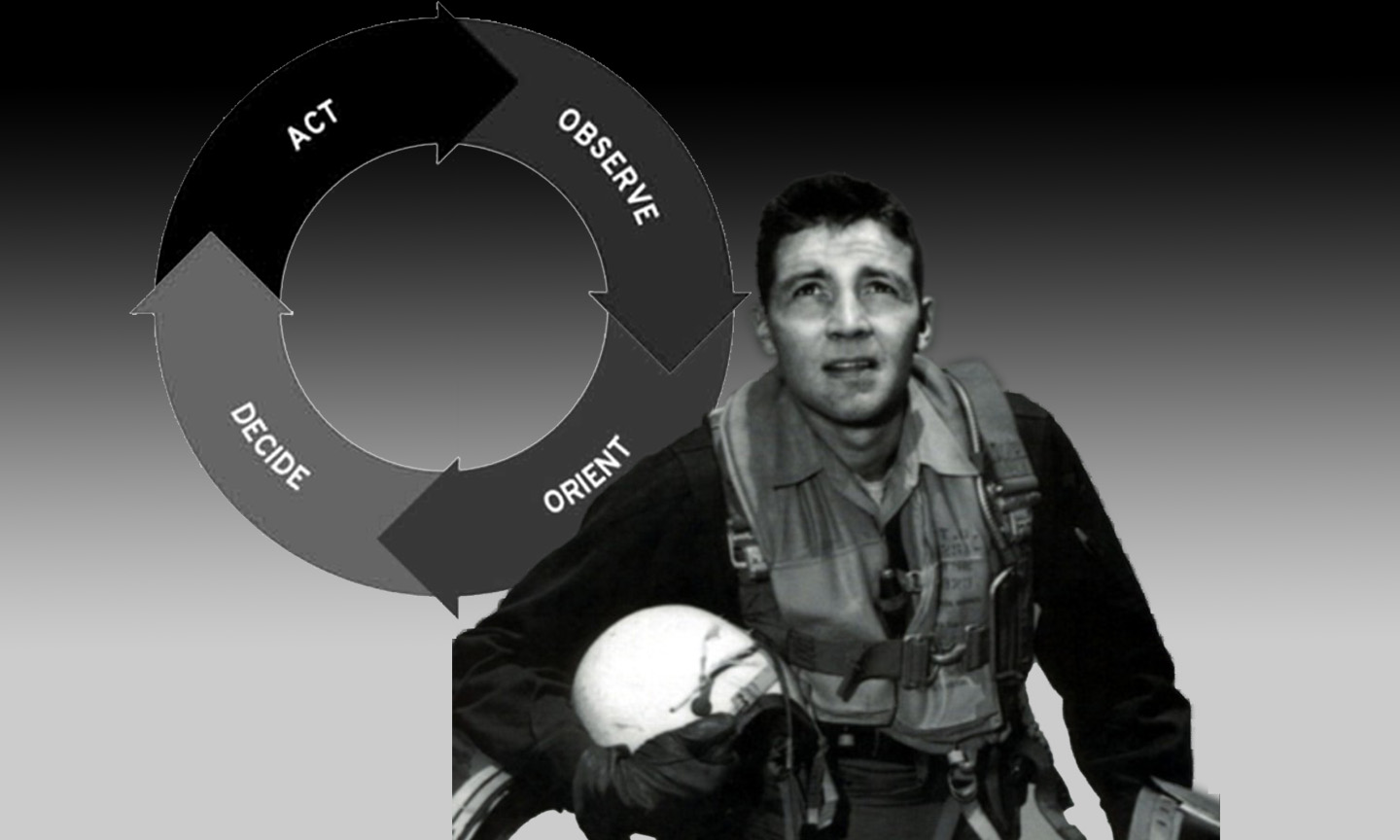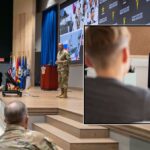
- &url=https%3A%2F%2Fwarroom2.armywarcollege.edu%2Fspecial-series%2Fgreat-strategists%2Fboyd-ooda-loop-great-strategists%2F&hashtags=WAR_ROOM" title="Share on Twitter" onclick="essb.window('https://x.com/intent/post?text=(GREAT%20STRATEGISTS)\%22>&url=https%3A%2F%2Fwarroom2.armywarcollege.edu%2Fspecial-series%2Fgreat-strategists%2Fboyd-ooda-loop-great-strategists%2F&hashtags=WAR_ROOM','twitter','723463277'); return false;" target="_blank" rel="noreferrer noopener nofollow" class="nolightbox essb-s-bg-twitter essb-s-bgh-twitter essb-s-c-light essb-s-hover-effect essb-s-bg-network essb-s-bgh-network" >
The OODA loop kinda represents how … humans and organizations learn, grow, and survive
A BETTER PEACE continues its series on Great Strategists with a look at airpower theorist John Boyd, who conceived of the “OODA” (Observe, Orient, Decide, and Act) Loop. Originally expressing an approach to tactical engagement, Boyd later expanded the idea to incorporate broad strategic action. How can individuals, organizations, and entire forces use this action-and-feedback mechanism to shape an uncertain environment and outthink the opponent? Discussing Boyd, his legacy, and contemporary views of his theories are U.S. Army War College professors Clay Chun and Jacqueline E. Whitt.
Podcast: Download
Subscribe: Apple Podcasts | Spotify | Amazon Music | Android | Pandora | iHeartRadio | Blubrry | Podchaser | Podcast Index | TuneIn | Deezer | Youtube Music | RSS | Subscribe to A Better Peace: The War Room Podcast
Clay Chun is Chair of the Department of the Distance Education at the U.S. Army War College. Jacqueline E. Whitt is Professor of Strategy at the U.S. Army War College and is the Editor of A BETTER PEACE. The views expressed in this presentation are those of the speakers and do not necessarily reflect those of the U.S. Army War College, U.S. Army, or Department of Defense.
Image: Portrait of John Boyd as a Captain or Major flying as a wingman (U.S. Government photo via Wikimedia Commons, public domain); OODA Loop graphic from Air University (public domain)
Image Composed by Tom Galvin
More podcasts from the “Great Strategists” series:
- WAR ON THE 21ST CENTURY BATTLEFIELD: REVISITING GENERAL STARRY’S CONCEPTUAL FRAMEWORK
- HORSESHOES, RELATIONSHIPS, AND SHARED UNDERSTANDING: CHESTER NIMITZ’S ART OF COMMAND
- BERNARD FALL: FORGOTTEN THEORIST OF WAR
(GREAT STRATEGISTS) - K.M PANIKKAR: INDIAN SCHOLAR, DIPLOMAT, STRATEGIST
(GREAT STRATEGISTS) - HOW MUCH FOR THE PEN? SCHELLING
(GREAT STRATEGISTS) - A SCIENTIFIC APPROACH TO WAR? ANTOINE-HENRI JOMINI
(GREAT STRATEGISTS) - THE NATURE AND CHARACTER OF WAR — THUCYDIDES
(GREAT STRATEGISTS) - BEYOND THUCYDIDES: HERODOTUS, XENOPHON & UNDERSTANDING WAR
(GREAT STRATEGISTS) - JOHN WARDEN AND THE ENEMY AS A SYSTEM
(GREAT STRATEGISTS) - JOHN BOYD AND THE “OODA” LOOP
(GREAT STRATEGISTS)
- &url=https%3A%2F%2Fwarroom2.armywarcollege.edu%2Fspecial-series%2Fgreat-strategists%2Fboyd-ooda-loop-great-strategists%2F&hashtags=WAR_ROOM" title="Share on Twitter" onclick="essb.window('https://x.com/intent/post?text=(GREAT%20STRATEGISTS)\%22>&url=https%3A%2F%2Fwarroom2.armywarcollege.edu%2Fspecial-series%2Fgreat-strategists%2Fboyd-ooda-loop-great-strategists%2F&hashtags=WAR_ROOM','twitter','1990880572'); return false;" target="_blank" rel="noreferrer noopener nofollow" class="nolightbox essb-s-bg-twitter essb-s-bgh-twitter essb-s-c-light essb-s-hover-effect essb-s-bg-network essb-s-bgh-network" >





Respectfully, this is a tragically one-dimensional view of Boyd’s theories and applications. Acknowledging the time limitations, of course. 1) Boyd’s OODA was in print…his graphic OODA loop slide is accompanied by his recorded briefings. 2) Orientation is everything. Formative experiences, entry-level training, commander’s intent, and mission command are all elements of orientation. This informed every element of readiness, and sets up freedom of action for the decision maker at every level, enabling the entire force to operate faster. 3) Diminishing the theory as a “fighter-pilot’s view” to a 1 v.1 fighter aircraft encounter is reductionist and shortchanges the value of the theory. It is not zero-sum. It would have been useful to elevate the questions past the “fighter pilot” characterization to the larger maneuver warfare applications as they have been experienced by the force at large.
Thanks-Jeff Dinsmore (US Marine…of course)
Respectfully, this is a tragically one-dimensional view of Boyd’s theories and applications. Acknowledging the time limitations, of course. 1) Boyd’s OODA was in print…his graphic OODA loop slide is accompanied by his recorded briefings. 2) Orientation is everything. Formative experiences, entry-level training, commander’s intent, and mission command are all elements of orientation. This informed every element of readiness, and sets up freedom of action for the decision maker at every level, enabling the entire force to operate faster. 3) Diminishing the theory as a “fighter-pilot’s view” to a 1 v.1 fighter aircraft encounter is reductionist and shortchanges the value of the theory. It is not zero-sum. It would have been useful to elevate the questions past the “fighter pilot” characterization to the larger maneuver warfare applications as they have been experienced by the force at large.
Thanks-Jeff Dinsmore (US Marine…of course)